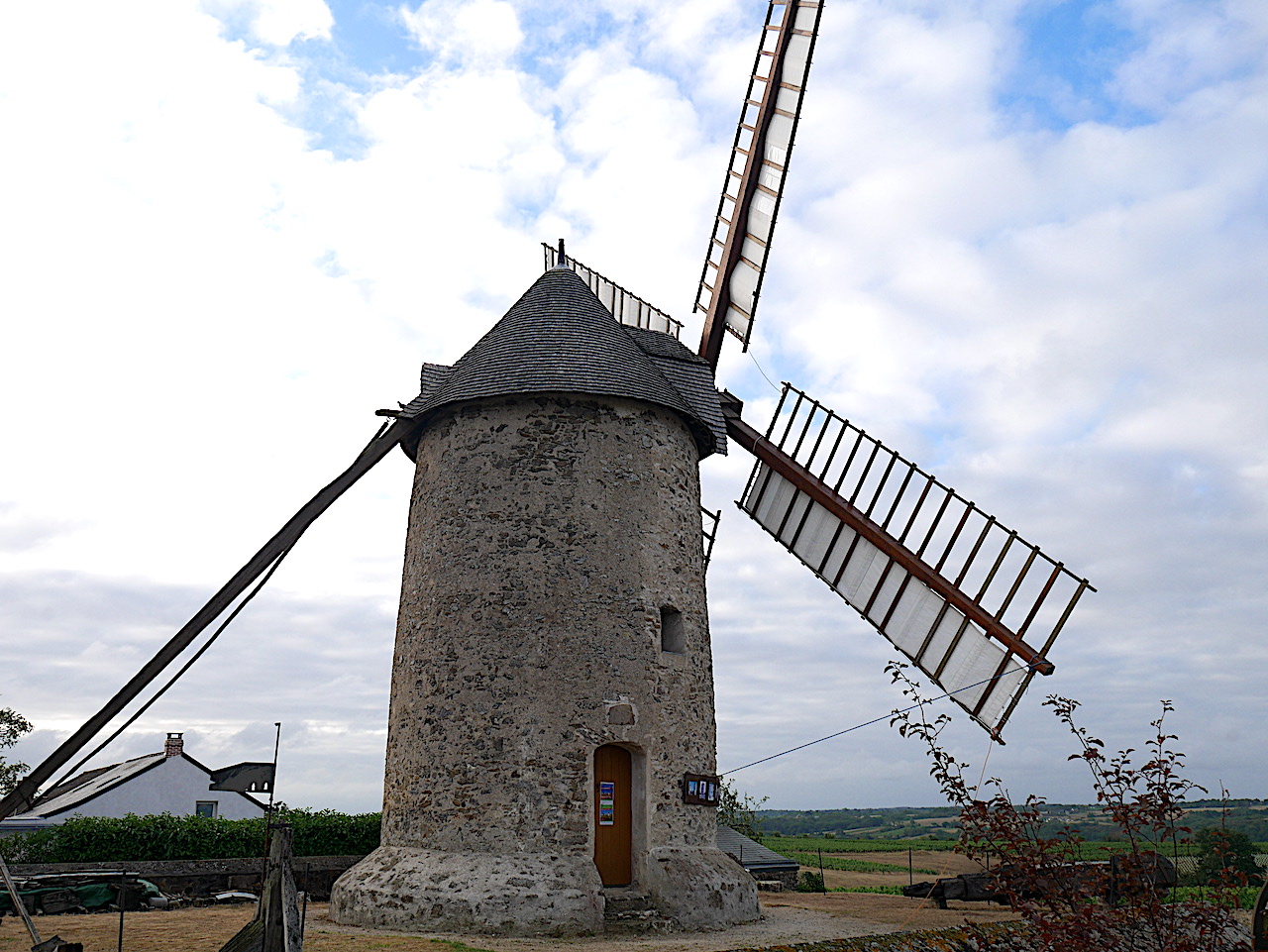
2. Rochefort-sur-Loire to La Pommeraye-Mauges-sur-Loire
Les vignes des coteaux du Layon vous accueillent dès votre sortie de la ville de Rochefort-sur-Loire, les vallons se succèdent avec une pause à l’ancien moulin Guérin pour admirer le paysage. Après une promenade dans le vignoble vous arrivez à Ardenay avec ses deux moulins restaurés par un passionné, la visite est incontournable pour comprendre le passé de ces monuments devenus historiques. Une halte à Chalonnes-sur-Loire est nécessaire pour admirer les quais de Loire, l’église Saint-Maurille, les ruines du château féodal avec son port de chargement médiéval. Un commerce prospère a baigné cette ville. En marchant à proximité de la Loire vous arrivez à la chapelle Saint-Aubin, son histoire vous surprendra. La dynamique ville de la Pommeraye à Mauges-sur-Loire marquera la fin de cette étape.
7 points of interest
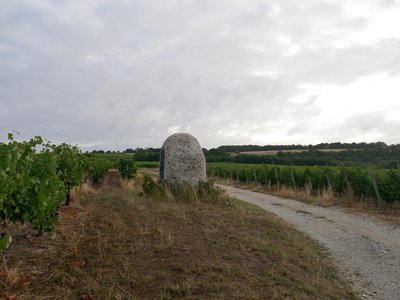
Puit dans le Coteau du Layon à coté du Moulin Guérin - Amis saint Colomban PanoramicVineyard of the Layon hillsides
The slopes of the Layon have been on the ground since the end of the 16th century under the impetus of Dutch traders. They were lovers of these wines, whose high alcohol content allowed them to keep well during their travels, and whose quality, by extension, the cost, was high enough to allow them to pay export taxes by Brittany.
In 1741, the Layon was channelled to facilitate the transport of goods such as wine or coal. The port city of Chalonnes-sur-Loire prospered with trade on the Loire.
During the Vendée wars, the region was set on fire and the infrastructure destroyed. Only the villages of Saint-Aubin-de-Luigné and Rochefort-Sur-Loire were spared.
The wines of the Coteaux-du-Layon are sweet and syrupy wines, with an aromatic richness that is endless.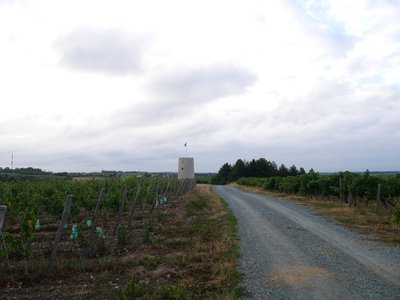
Moulin Guérin à Saint-Aubin de Luigné - Amis saint Colomban HistoricalThe Guérin Mill in Saint-Aubin de Luigné
The tourist information office of Saint-Aubin has set up a belvedere with an orientation table at the top of the Moulin-Guérin. From there, you can enjoy a splendid panoramic view of the Mauges plateau and the Layon valley.
During the wars of Vendée the mills allowed to communicate, several were burned.
Before the vine occupied all the agricultural land, the cultivation of cereals was important and justified the construction of windmills and water mills.
Moulins d’Ardenay au col d’Ardenay (altitude : 75 m.) - Amis saint Colomban HistoricalThe mills of Ardenay
Built in the 18th century, the Ardenay windmills are angevin windmills located in the commune of Chaudefonds-sur-Layon.
The village of Ardenay dominates the Loire and Layon valleys, in the heart of the Coteaux du Layon, at an altitude of 77 metres. The two mills in Ardenay were built at the end of the 18th century (contemporary era). The department will have 640 windmills at the beginning of the 19th century. Both mills are tower mills and will be equipped with Berton wings, an adjustable lift wing system, during the 19th century. The western mill, known as the Grand-Moulin, is a cheese mill (wheat), and the eastern mill, known as the Petit-Moulin, is a rye mill (rye). One of them has been renovated and equipped with canvas wings. You can also see a space on the life of the miller, an exhibition on the mills of Anjou.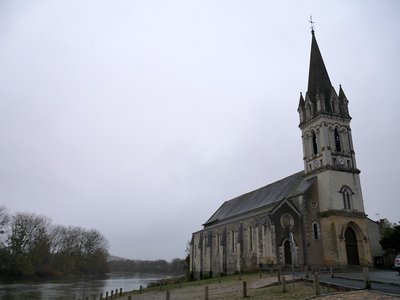
Église Saint-Maurille à Chalonnes-sur-Loire - Amis saint Colomban TouristSaint-Maurille Church in Chalonnes-sur-Loire
Built on the site of the primitive "cella", it was built by Saint Maurille on his landing island when this disciple of Saint Martin came to convert the country, a centre of paganism. During the revolution, it was used for soldiers' bivouacs and as a fodder storage area. It was restored in 1846-1847 and since then the bell tower had to be repaired following the 1940 bombing.
The choir and the northern chapel date from the 13th century.
The Contemporary Stained Glass Stained Glass by Pierre Mabille is a public state commission inaugurated in June 2014. The state public commission has made it possible to create 12 contemporary stained glass windows. They were made by the Duchemin workshops in Paris. They were inaugurated under the aegis of the Ministry of Culture in June 2014.
Saint Maurille († 453) is a bishop of Angers, considered holy by the Catholic and Orthodox Church. He is the patron saint of fishermen and gardeners. In Roman Catholic iconography he is represented as a bishop with a fish and holding a key or a spade.
he only authentic Life of Saint Maurille was written by Mainbeuf d'Angers, one of his successors, around 620. Maurille was born into a rich Milanese family. They very quickly put him under the leadership of the future Saint Martin who, coming from Hungary, had built a monastery in Milan for young people.
Saint Ambrose then took Maurille as his reader. At the age of twenty, he left his family and country to take over the direction of Martin de Tours, where he had been appointed bishop. Martin ordained him a priest and sent him to Angers to work for the salvation of souls.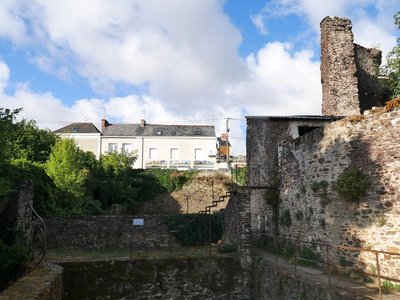
Vue des vestiges du château épiscopal de Chalonnes-sur-Loire - Amis saint Colomban HistoricalEpiscopal castle and the port of Saint-Pierre de Chalonnes-sur-Loire
It is difficult to get an idea of the importance of the castle at this time because the moat has been filled, the keep razed and the enclosure almost destroyed. A wall in small irregular apparatus would indicate a time before the 11th century. The Saint-Pierre tower (15th century) is the last tower still visible. This powerful episcopal castle was surrounded by moats and moats. The main dwelling included a pavilion with two large rooms and an oratory in a tower on the banks of the Loire, the base of which served as a prison.
In Chalonnes the river activity was important. For a long time, the Loire was a strategic transport route. Ports have been built to accommodate more and more ships. After the opening of the Layon Canal in 1778, the quays became the loading point for the Layon wines that the Dutch came to buy. There was also lime and coal. In the 19th century, other ports were built which today merge with the quays and via Columbani: Port Chailloux, Port Saint-Maurille and Port Garou. River transport was then abandoned in favour of the railway and the last bargemen abandoned their traffic around 1913.
Vue du prieuré de Chateaupanne avec la colline des carrières de calcaire en arrière-plan. - Amis saint Colomban TouristChapel Saint-Aubin in Chateaupanne in Montjean-sur-Loire
Founded in the 7th century, the parish of Chateaupanne was destroyed in the 9th century. On the south side of the priory enclosure, the Romanesque church has a single nave from the 11th century (with remains of paintings from the 13th century) and a 15th century choir (also with paintings, of which Christ judges from the middle of the 15th century).
Superbly restored, this chapel is worth a visit. An exhibition presents the work carried out.
Saint-Aubin d'Angers
Born in the diocese of Vannes around 469, saint aubin was first abbot of Nantilly, near Saumur. He became bishop of Angers where he is the heavenly patron. Shining with charity in a barbaric and cruel world, he was one of the main promoters of the Third Council of Orleans, which reformed the Frankish Church with great firmness.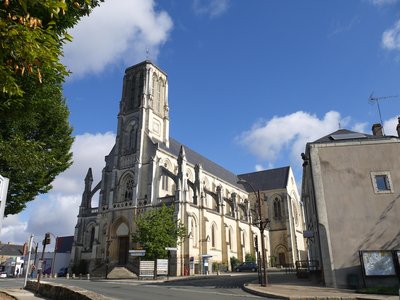
Église Saint-Martin de La Pommeraye - Amis saint Colomban TouristSaint-Martin church in La Pommeraye Mauges-sur-Loire
Saint-Martin church was built from 1864 to 1867, outside the old town in the presbyteral enclosure on the site of the former parish church.
In the shape of a Latin cross, in the ogival style with its three naves and two transepts, each decorated with a large rosette, built in tufa, it is difficult to resist the ravages of time.
Description
- At the crossroads on your right, junction with the asphalt road in the vineyard, on the left before the bend, at the crossroads on the right vine path after the bend on the left take a dirt road on the left at the crossroads cross the road D54
- In the hamlet, take the vine path on the left between the houses, first vine path on the right, on the right pass in front of the Guérin mill, straight ahead, at the crossroads follow the small grove in front of you. Go around the Clos de la Motte, on the right to cross the D 54 straight on in the vineyard, on the left, a dirt track. Turn right at the crossroads and turn left.
- Cross the D 751, first road on the left, chemin des Roseraies, on the left cross the crossroads of D 751 and D 54 take the first road on the right, on the left straight on in the vineyards, stay on the main road
- Ardenay, right at the crossroads with asphalt road D 121, first street on the left, rue des Grands Crus, left rue des Vignes, right chemin rural des Grands Champs aux Touches, left towards Les Moulins, right chemin
- Stay on the main road on the right at the junction with the asphalt road, cross the railway line, straight ahead, Montée de Pierre Couts, cross the avenue de la Gare to follow the path along the bassin du Layon, Tour du Plan d'Eau, take the pedestrian bridge, on the right at the roundabout, turn right on rue des Moines, take the path that goes around the church on the right, follow the banks of the Loire until the exit of Chalonnes-sur-Loire.
- At the last house turn left, stay on the left-most path to leave the Loire river bank, between woods and vineyards at the crossroads straight ahead, go around the cereal field by the right, straight ahead, left at the junction with an earthen and then tarred farm track.
- Second path on the left between the houses, on the right on D 751, first path on the right between bushes, at the farm on the left then on the right, at the crossroads on the left in front of the house, path housing the wood, on the left at the crossroads, twice on the right at the dirt track, first path on the right between bushes
- Cross the brook "Ruisseau des Moulins", go around the "Moulin de Bois Gelé" on the left, follow the path along the brook "Ruisseau des Moulins", pass in front of the "Moulin d'Argogne" and continue along the brook.
- Go round the Moulin de Bene by going up the hill on the right, follow the white and red markings, cross the D 131, first road on the right in the woods, cross the hamlet of Les Béhuards, turn right in the direction of La Pommeraye, go along the riding school.
- Left rue de la Guimonière, right avenue du Huit Mai, allée des Roses, rue des Carmélias, left rue des Lilas, right rue des Mauges, you arrive at the church Saint-Martin de Vertoux.
- Departure : Sainte-Croix Church, 7-11 Place Sainte-Croix, 49 190 Rochefort-sur-Loire
- Arrival : Saint-Martin de Vertoux Church, 1 Rue de la Loire, La Pommeraye, 49 620 Mauges-sur-Loire
- Towns crossed : Pays de la Loire
Altimetric profile
Transport
Report a problem or an error
If you have found an error on this page or if you have noticed any problems during your hike, please report them to us here:








